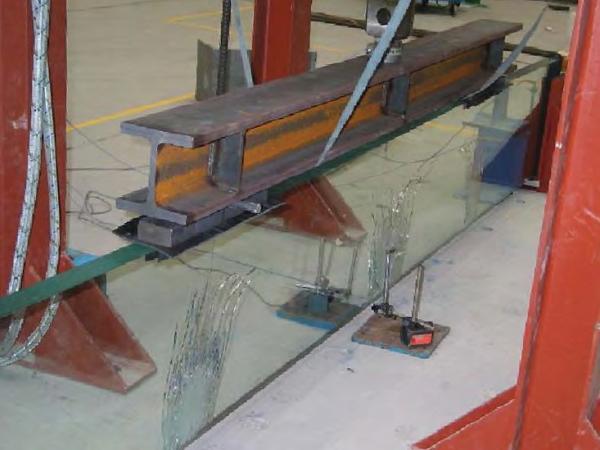AUTHORS: Michel Palumbo, Dominque Palumbo, Teresa Mazzucchelli
Introduction
Although the standard glass design strategy is redundancy, we pursue a safer way to ensure the robustness of transparent glass beam structures. To attain this goal:
- the first design principle is to give up using the traditional all-tempered laminated-glass beams, because the high resistance due to the tempering process entails no post-peak resistance;
- the second design criterion (largely adopted in the past) is to reinforce annealed glass sheets with high-strength reinforcing materials (according to a patented glass-toughening protocol). In this case, we lose the strength of tempered glass but we gain substantial post-peak resistance of the whole glass beam (should all the glass layers fracture, the reinforcing belt would interconnect all the macro glass shards and sustain the tensile load, whilst the fractured glass would continue to transmit compressive loads). [1]
- the third guideline is to wisely combine thermally strengthened glass sheets with reinforced annealed glass layers.
Since glass is being increasingly used as a structural load bearing element, the patented innovation we describe herewith meets the two most important demands concerning structural glass: to increase the load bearing capacity of glass beams in conjunction with a high post-peak mechanical behaviour.
The main idea is to combine a reinforced glass beam core (to guarantee safety), based on annealed glass sheets, with the higher-strength resistance of fully tempered glass. The stacking sequence, the reinforcement and all the materials used to assemble the glass beams are calculated according to the different loading conditions, humidity level and structural characteristics of the context to suit the safety and aesthetic needs of the fi nal user. In Figure 1, we show an example of the high-strength and toughened glass beam described above.
Figure 1. Underneath view of a hybrid glass beam. Both the steel reinforcing belt (glued to annealed glass layers) and glass load-bearing sheets can be seen
Results and discussion
The beams underwent preliminary four-point bending testing to simulate consistent load conditions.
The tested beam dimensions are reported in Figure 2.
Figure 2. Hybrid glass beam dimensions
Figure 3. Hybrid glass beam test setup
The force-displacement plot of the four-point bending test is reported in Figure 4.
All the glass layers bear the external loads in standard conditions. As the load increases, the inner glass panes start to crack in the middle and act as a warning signal. As the load increases, the reinforcing plate comes into play by redistributing the external pressure over the sides of the cracks, as described below in detail [1] (Figure 5).
New cracks appear far from the beam midspan. The beam system is still able to withstand the loads because of the reinforcing belt and the presence of tempered glass sheets.
Once the outer glass pane breaks, the hybrid glass beam system (steel-reinforced glass beam and anchoring brackets) is still able to sustain external loads because of the presence of the toughened and reinforced core [1-3].
All the cracks shown in Figure 5 appear in the toughened annealed-glass core.
The beam is still able to withstand loads until the outer tempered glass layers break. After that, the glass beam behaves as an annealed-glass reinforced beam and offers the post-peak resistance as described elsewhere, i.e. [1], [2], [3].
Figure 4. Force - displacement plot of the hybrid toughened, reinforced glass beam
Figure 5. Cracks progression based on the strain of the core toughened by means of high-strength strips
Conclusions
Glass is and will remain one of the most important materials in architecture. The results reported in this paper show the possibilities of adding extra value to glass if used in special structures. The brittleness of the material not only requires sophisticated global structural analyses (managed by the latest software tools) but also creates new challenges with regard to the detailing and assembly process.
Even if glass sizing is the fi rst step to take when glass is used as a load bearing material, we must remember that many parameters affect the strength and the safety of a glass beam, i.e. stress corrosion, moisture, local defects or scratches, stress concentration, finishing of the loaded edges [4] and … load transfer between glass and context.
Anchoring brackets design is a fundamental step of the glass design process, since they transfer the external loads from the glass beam to the outer structure. It is of the utmost importance to avoid stress concentration on the glass inside the brackets, since low global stress may locally increase to unacceptable values for glass. Thus the design of a reinforced, toughened glass beam can not ignore the design of the glass layup, the reinforcing strip, the redistribution of the external loads and the supports of the whole glass system.
References
1. M. Palumbo and al., Structural glass beams supporting a new transparent roof, XXV A.T.I.V. Conference Parma (Italy) November 18-19, 2010;
2. Glass Processing Days - 16-21/06/2005 Tampere - Finland;
3. Tesi di Laurea Università di Brescia (Italy) “Vetro per gli impieghi strutturali” - 2006 U. Balestrieri e L. Bartoli;
4. Haldimann, M and Luible, A and Overend, M (2008), Structural use of glass. Iabse.
Authors
Michel Palumbo, Dominque Palumbo, Teresa Mazzucchelli
Vetrostrutturale srl - Viale Venezia 220
25123 Brescia
michel.palumbo@vetrostrutturale.it




















